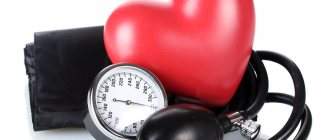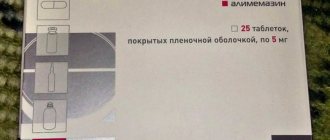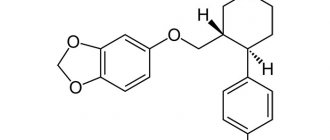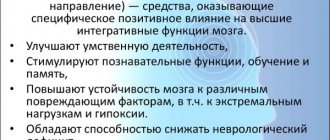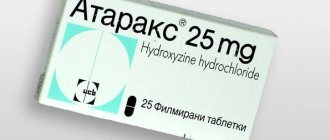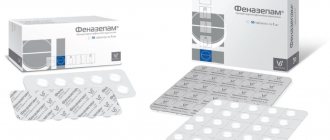Release form and composition
Triftazin is available in the following forms:
- round biconvex tablets of 5 or 10 mg, coated with a blue or blue-green coating (marbling is allowed), two layers are possible on the cross section. The tablets are packaged in blisters of 10 or 50 pcs. or dark glass jars of 50 or 100 pcs. and in cardboard packs (1 or 5 blisters or 1 can in a pack) or cardboard boxes for hospitals (100, 300 or 450 blisters per box);
- solution for intramuscular administration 0.2%. A transparent, colorless or slightly colored liquid is poured into glass ampoules of 5 ml, the ampoules are packaged in blisters (5 ampoules each) and packaged in cardboard packs (10 ampoules or 2 blisters each) or cardboard boxes (100 blisters each).
1 tablet contains:
- active ingredient: trifluoperazine hydrochloride – 5 or 10 mg;
- excipients: calcium carbonate (precipitated), sucrose, liquid paraffin, potato starch, colloidal silicon dioxide, glycerol, magnesium stearate, gelatin, beeswax, talc, indigo carmine.
Contains 1 ml of solution:
- active ingredient: trifluoperazine – 2 mg;
- excipients: sodium citrate pentasesquihydrate, water for injection.
Contraindications
- severe cardiovascular diseases (arterial hypotension, decompensated chronic heart failure);
- pronounced depression of central nervous system function (including as a result of taking medications);
- progressive diseases of the brain and spinal cord;
- traumatic brain injuries;
- inhibition of bone marrow hematopoiesis;
- comatose states of any etiology;
- severe liver failure;
- age up to 6 years;
- hypersensitivity to phenothiazine derivatives and any ingredients of the drug.
Triftazin is prescribed with caution in the following cases:
- damage to the heart valves, which limit the amount of minute blood volume;
- angina pectoris;
- increased susceptibility to hepatotoxic reactions;
- pathological disorders of hematopoiesis;
- alcoholism;
- mammary cancer;
- liver and/or kidney failure;
- Parkinson's disease;
- angle-closure glaucoma;
- prostatic hyperplasia with clinical manifestations;
- exacerbation of stomach and duodenal ulcers;
- diseases that are accompanied by an increased risk of thromboembolic complications;
- epilepsy;
- myxedema;
- chronic diseases that are accompanied by breathing problems (especially in childhood);
- Reye's syndrome (especially in childhood and adolescence);
- vomit;
- cachexia;
- elderly age.
Directions for use and dosage
Triftazin tablets are taken orally after meals. The dose is selected individually depending on the severity of the condition. After achieving the maximum therapeutic effect, the dose is gradually reduced to a maintenance dose.
For patients with mental disorders, at the beginning of therapy, 5 mg of the drug is prescribed 2 times a day, after which over 2-3 weeks the daily dose is gradually increased to 15-20 mg (divided into 2-3 doses). The maximum dose of Triftazin is 40 mg per day. The desired therapeutic effect and improvement in the patient’s condition usually occurs within 2–3 weeks.
At the first stage of treatment of weakened, depleted, elderly patients and children, it is recommended to use dosage forms with a lower content of trifluoperazine. Weakened, debilitated and elderly patients should receive a lower initial dose, which is gradually increased based on tolerability.
When using Triftazin as an antiemetic, the recommended daily dose for adults is 5 mg.
The drug solution is administered intramuscularly every 4–6 hours, 1–2 mg. The maximum daily dose should not exceed 10 mg.
At the first stage of treatment of weakened, exhausted and elderly patients, the initial dose is reduced by 2 times.
For children over 6 years of age, the recommended dose of the drug is 1 mg 1–2 times a day.
Bibliography
- ICD-10 (International Classification of Diseases)
- Yusupov Hospital
- World Health Organization. F4 Neurotic, stress-related, and somatoform disorders // International Classification of Diseases (10th revision). Class V: Mental and behavioral disorders (F00-F99) (adapted for use in the Russian Federation). - Rostov-on-Don: Phoenix, 1999. - P. 175-176. — ISBN 5-86727-005-8.
- Shear MK, Brown TA, Barlow DH, Money R, Sholomskas DE, Woods SW, Gorman JM, Papp LA. Multicenter collaborative Panic Disorder Severity Scale. American Journal of Psychiatry 1997;154:1571-1575 PMID 9356566.
- Pharmacotherapy in neurology and psychiatry: [Trans. from English] / Ed. S. D. Enna and J. T. Coyle. - Moscow: LLC: "Medical Information Agency", 2007. - 800 pp.: ill. With. — 4000 copies. — ISBN 5-89481-501-0.
We invite you to read: How to stop drinking alcohol on your own: medical, folk methods
Side effects
When taking Triftazin, the following side effects may develop from the central nervous system:
- insomnia (at the initial stage of treatment) or drowsiness;
- dry mouth;
- dizziness;
- dystonic extrapyramidal disorders (inability to move the eyes, spasms of the muscles of the back, neck and face, tic-like twitching or movements, weakness in the legs and arms, bending movements of the torso);
- akathisia;
- parkinsonism (mask-like face, difficulty swallowing and speaking, loss of balance control, shuffling gait, trembling of fingers and hands, stiffness of legs and arms);
- tardive dyskinesia (puffing of the cheeks, wrinkling of the lips, smacking, worm-like or rapid movements of the tongue, uncontrolled movements of the legs and arms, chewing movements);
- neuroleptic malignant syndrome (increased or difficult breathing, irregular pulse or rapid heartbeat, convulsions, hyperthermia, unstable blood pressure, sweating, severe muscle rigidity, loss of urinary control, unusual weakness and fatigue, pallor);
- paradoxical reactions (psychomotor agitation, hallucinations);
- mental changes (delayed reaction to external stimuli, mental indifference, etc.);
- isolated cases - convulsions.
The drug can also cause a number of other side effects:
- cardiovascular system: heart rhythm disturbances, tachycardia, increased frequency of angina attacks with increased physical activity, decreased or inverted T wave, prolongation of the QT interval; at the initial stage of treatment - a decrease in blood pressure (including orthostatic hypotension), especially in alcoholics and elderly patients;
- digestive system: constipation (at the initial stage of treatment), nausea, loss of appetite, vomiting, bulimia, anorexia, diarrhea, gastralgia; rarely – hepatitis, cholestatic jaundice, intestinal paresis;
- endocrine system: amenorrhea, hyper- or hypoglycemia, glycosuria, weight gain, hyperprolactinemia, galactorrhea, gynecomastia, dysmenorrhea, pain in the mammary glands or their swelling;
- sensory organs: accommodation paresis (at the initial stage of treatment), blurred visual perception; with long-term use - clouding of the cornea and lens, retinopathy;
- genitourinary system: frigidity (at the initial stage of treatment), decreased libido and potency, priapism, ejaculation disorders, oliguria, urinary retention;
- allergic reactions: angioedema, skin rash, exfoliative dermatitis, urticaria;
- laboratory indicators: thrombocytopenia, leukopenia, anemia, pancytopenia, agranulocytosis (usually on days 4–10 of treatment), eosinophelia, hemolytic anemia, false-positive pregnancy tests and phenylketonuria;
- other: discoloration of the cornea and sclera, photosensitivity, staining of the conjunctiva and skin, myasthenia gravis, reduced tolerance to high temperatures (possible development of heat stroke).
Taking antipsychotics of the phenothiazine group was accompanied by cases of sudden death (presumably due to cardiac causes).
Restrictions on use
The medication is an antipsychotic agent with sedative, antiemetic, antihiccup, hypomermic, cataleptic, hypotensive and mild m-anticholinergic effects. Triftazine is similar in structure to chlorpromazine, but has higher activity and is better tolerated.
An analogue of Triftazin in terms of the active substance is Triftazin-Darnitsa. Analogs of Triftazin according to the mechanism of action and belonging to the same pharmacological group include:
- Majeptyl;
- Metherazine;
- Moditen;
- Etaperazine.
The drug Triftazin is used in cases of schizophrenia, psychosis, hallucinatory and affective-delusional states, psychomotor agitation and vomiting (of central origin).
In accordance with the instructions, Triftazin tablets are taken orally with plenty of water, or administered intramuscularly in the form of a solution. The dosage of the drug depends on age and disease. For the treatment of anxiety syndrome with Triftazin tablets, the dose is 1-2 mg twice a day, the maximum dose is 6 mg per day, for no more than 12 weeks.
When treating psychotic disorders, the drug is prescribed in an amount of 2.5-5 mg twice a day, orally, increasing to 15-20 mg per day for 2-3 weeks, the maximum dose is 40 mg per day. The use of Triftazin orally in elderly and debilitated patients begins with a lower initial dose, which can be increased if necessary. For children over the age of 6 years, the dosage of the drug is 1 mg 1-2 times a day with a possible gradual increase.
A single dosage of Triftazin for intramuscular administration is 1-2 mg every 4-6 hours, but not more than 10 mg per day. In accordance with the instructions, Triftazin is prescribed to elderly people, as well as weakened and exhausted patients in an initial dose reduced by 2 times. For children over 6 years of age, the dosage of the medication is 1 mg 1-2 times a day.
According to reviews, the use of Triftazin can lead to complications from various body systems in cases of overdose, namely:
- Nervous system: insomnia, dizziness, drowsiness, akathisia, parkinsonism, tardive dyskinesia, dystonic extrapyramidal reactions, neuroleptic malignant syndrome, phenomena of mental indifference, mental changes and delayed reaction to external stimuli;
- Endocrine system: hypoglycemia, glycosuria, hyperprolactinemia, galactorrhea, pain or swelling in the mammary glands, amenorrhea, hyperglycemia, dysmenorrhea and weight gain;
- Genitourinary system: oliguria, decreased potency, priapism, frigidity, decreased libido, impaired ejaculation and urinary retention;
- Digestive system: nausea, loss of appetite, dry oral mucosa, constipation, gastralgia, bulimia, anorexia, vomiting, diarrhea, cholestatic jaundice, hepatitis and intestinal paresis;
- Hematopoietic organs: leukopenia, thrombocytopenia, pancytopenia, agranulocytosis, eosinophilia and hemolytic anemia;
- Sense organs: visual impairment (paresis of accommodation), clouding of the lens and cornea, retinopathy and blurred vision;
- Cardiovascular system: reduction or inversion of the T wave, prolongation of the QT interval, heart rhythm disturbances and increased frequency of angina attacks.
In addition, Triftazin, according to reviews, can cause other disorders, namely:
- Skin rash;
- Angioedema;
- Urticaria;
- Exfoliative dermatitis;
- Conjunctiva;
- Skin coloring;
- Photosensitivity;
- Discoloration of the sclera and cornea;
- Myasthenia;
- Phenylketonuria.
https://www.youtube.com/watch?v=ytpressru
Also, the use of Triftazin, according to reviews, can lead to the development of heat stroke, loss of the ability to sweat, confusion and false positive pregnancy tests.
An overdose of the drug can lead to neuroleptic malignant syndrome, low blood pressure, hypothermia, tachycardia, gynecomastia, coma, collapse and toxic hepatitis.
Use of the drug
Contraindicated during pregnancy.
If it is necessary to use the drug, you must stop breastfeeding.
When used simultaneously
- with drugs that depress the central nervous system (anesthetics, opioid analgesics, barbiturates, anxiolytics, ethanol and ethanol-containing drugs) - increased central nervous system depression and respiratory depression are possible;
- with tricyclic antidepressants, maprotiline or MAO inhibitors - the risk of neuroleptic malignant syndrome may increase;
- with anticonvulsants - the seizure threshold may be reduced;
- with drugs for the treatment of hyperthyroidism - the risk of developing agranulocytosis increases;
- with drugs that cause extrapyramidal reactions - an increase in the frequency and severity of extrapyramidal disorders is possible;
- with antihypertensive drugs - orthostatic hypotension is possible
- with prochlorperazine - prolonged loss of consciousness is possible;
- with adrenaline, then adrenomimetics and sympathomimetics - a paradoxical decrease in blood pressure is possible
- with drugs that prolong the QT interval (antiarrhythmics, non-sedating antihistamines, antimalarials, cisapride, diuretics, tricyclic antidepressants), phenothiazine derivatives - there may be an increased risk of developing ventricular arrhythmia
https://www.youtube.com/watch?v=https:accounts.google.comServiceLogin
- from α-adrenergic receptors - enhancing the hypotensive effects of trifluoperazine;
- with antiepileptic drugs - decreased effect of antiepileptic drugs;
- with astemizole, disopyramide, erythromycin, procainamide - increased risk of developing tachycardia;
- with propranolol, sulfadoxine - increase in the concentration of trifluoperazine in the blood plasma
- with polypeptide antibiotics - possible paralysis of the respiratory muscles;
- with trazodone - additive hypotensive effect
- with valproic acid - increase in the concentration of valproic acid in the blood plasma
- bromocriptine - phenothiazines inhibit the ability of bromocriptine to reduce the concentration of prolactin in the blood serum.
CYP1A2 inducers reduce the concentration and effect of trifluoperazine, CYP1A2 inhibitors increase the concentration and effect of trifluoperazine.
https://www.youtube.com/watch?v=ytaboutru
The drug may reduce the effect of oral anticoagulants.
Prescribe with caution simultaneously with anti-tuberculosis antibacterial agents.
The drug can weaken the vasoconstrictor effect of ephedrine, enhance the anticholinergic effects of other drugs, and suppress the effect of amphetamines, levodopa, clonidine, and guanethidine.
Antacids, antiparkinsonian drugs and lithium preparations interfere with the absorption of trifluoperazine.
Let's consider the main properties of the drug "Triftazin". Instructions for use (official) contain detailed information about the mechanism of action of the active substance of the drug on the receptors of the brain and vagus nerve in the gastrointestinal tract. So, it says that trifluoperazine blocks PMD receptors in the brain and D2 receptors in the cerebellum. In addition, the antipsychotic is capable of having an alpha-adrenergic blocking effect, that is, it actively affects blood pressure levels, reducing it.
MORE: Recipes and methods of treating VSD with folk remedies. Treatment of VSD with folk remedies - recipes and reviews
Trifluoperazine has not been studied in depth in terms of pharmacokinetics, but it is known for certain that it actively binds to plasma proteins (at least 80%). The mechanism of the breakdown of the compound into metabolites has also been poorly studied. The drug is excreted from the body mainly through the kidneys; a small part of the active substance and its metabolites is excreted through the intestines (with bile).
The active substance of the drug "Triftazin" (doctors' reviews contain a lot of supporting information on this matter) has a negative effect on the developing fetus. That is why it is strictly not recommended to take the drug during pregnancy. The fact is that the active substance trifluoperazine is found in fetal tissues in concentrations significantly exceeding therapeutic doses. It is this that provokes weak weight gain in the fetus, and also increases the risk of developing various defects in its development.
The drug "Triftazin" (analogues of the active substance should also be taken into account) is not recommended for nursing women, since the components of the drug are found in breast milk. Even if the mother does not experience any side effects, the baby may face problems such as tardive dyskinesia and lethargy in the future.
Before starting to take a drug, many try to find reviews about it. The drug "Triftazin", judging by the comments of experts, is considered one of the most effective. At the same time, they note that uncontrolled use of the drug can negatively affect not only the physical, but also the mental state of a person.
For those patients who are prescribed this medication, in many cases it is the only way to lead a normal life. Of course, this does not happen without the development of side effects. But, according to statistics, all unpleasant symptoms disappear within a maximum of two weeks after the start of therapy.
Patients' opinions about the drug Triftazin are mixed. It really helped some, while others had such a hard time with the side effects that they had to give up this remedy. Very often, consumers indicate the appearance of fatigue, apathy and general weakness. In isolated cases, patients fell into a state where they did not want to make even basic movements.
Women, unlike men, often mention weight gain during treatment with Triftazin. Experts say that there is no direct relationship between therapy with this drug and weight gain. According to their assumption, this is due to a decrease in the physical activity of patients while maintaining the same diet.
https://www.youtube.com/watch?v=ytcopyrightru
Regarding the effect of the drug, both doctors and patients admitted that this drug really alleviates or completely eliminates the symptoms of the underlying disease.
| Rating: 4.9/5. Ratings: 263. |
special instructions
Due to possible disturbances in thermoregulation when taking Triftazin, exposure to high temperatures should be avoided.
During treatment with neuroleptics, neuroleptic malignant syndrome (possible death) can develop at any time. If signs of neuroleptic malignant syndrome and tardive dyskinesia appear, treatment should be discontinued.
During treatment, it is necessary to regularly monitor the functions of the hematopoietic system, cardiovascular system, kidneys and liver.
The drug is discontinued at least 48 hours before myelography, and its use is not resumed within 24 hours after the procedure. The drug cannot be used as an antiemetic before myelography.
The antiemetic effect of Triftazin can complicate the diagnosis of certain diseases (brain tumor, Reye's syndrome, intestinal obstruction), as well as mask signs of toxicity caused by an overdose of other drugs.
If symptoms of extrapyramidal disorders appear, the drug should be used in smaller doses or discontinued altogether. The decision to restart treatment is made by the doctor.
Correction of extrapyramidal disorders is carried out using antiparkinsonian drugs (for example, trihexyphenidyl). Dyskinesia is relieved by subcutaneous administration of a 20% caffeine solution (2 ml) and a 0.1% atropine solution (1 ml).
Drinking alcohol is prohibited while using Triftazin.
Patients taking Triftazin should refrain from driving moving machinery and vehicles.
Interaction with other drugs
From the visual system: development of retinopathy, accommodation paresis, clouding of the lens or cornea.
From the genitourinary system: development of frigidity, priapism, oliguria, decreased libido, decreased potency, impaired ejaculation, urinary retention.
From the endocrine system: development of amenorrhea, glycosuria, hyper/hypoglycemia, hyperprolactinemia, galactorrhea, dysmenorrhea, gynecomastia, mastalgia, swelling of the mammary glands, weight gain.
From the digestive system: the appearance of dry mouth, constipation, the development of bulimia, vomiting, gastralgia, diarrhea, cholestatic jaundice. Patients often experience decreased appetite.
From the cardiovascular system: the appearance of tachycardia, orthostatic hypotension, arrhythmia, decreased T wave or inversion, prolongation of the QT interval.
Laboratory indicators: development of thrombocytopenia, lympho- or leukopenia, anemia, agranulocytosis, eosinophilia, pancytopenia, increased blood clotting.
Allergic reactions: the occurrence of urticaria, skin rash, angioedema.
In addition, the development of melanosis, pigmentation of the conjunctiva, skin, discoloration of the sclera and cornea may be observed. Tolerance to high temperatures decreases, and heat stroke may develop.
Drug interactions
When using the drug simultaneously with other drugs, the following effects may develop:
- beta-blockers: increased hypotensive effect, increased risk of developing tardive dyskinesia, irreversible retinopathy and arrhythmia;
- antihypertensive drugs: orthostatic hypotension;
- prochlorperazine: prolonged loss of consciousness;
- lithium preparations: decreased absorption of lithium in the gastrointestinal tract and increased rate of excretion by the kidneys, increased severity of extrapyramidal disorders;
- CNS depressants (barbiturates, opioid analgesics, anesthetics, ethanol and ethanol-containing drugs, anxiolytics, etc.): respiratory depression and increased CNS depression;
- sympathomimetics (ephedrine), alpha and beta adrenergic agonists (epinephrine): paradoxical decrease in blood pressure;
- drugs that cause extrapyramidal disorders: increased severity and frequency of extrapyramidal reactions;
- tricyclic antidepressants, maprotiline, monoamine oxidase inhibitors: increased risk of developing neuroleptic malignant syndrome, increased and prolonged anticholinergic and sedative effects;
- anticonvulsants (including barbiturates): lowering the seizure threshold;
- diuretics: increased hyponatremia;
- drugs for the treatment of hyperthyroidism: increased likelihood of developing agranulocytosis;
- astemizole, probucol, erythromycin, cisaride, disopyramide, quinidine, procainamide, pimozide: additional prolongation of the QT interval;
- apomorphine: reducing the effectiveness of the emetic effect of apomorphine and enhancing its inhibitory effect on the central nervous system;
- phenamines: decrease in the antipsychotic activity of Triftazin and weakening of the effect of phenamines;
- prolactan: increased concentration of prolactan in plasma;
- aluminum, antidiarrheal adsorbents or antacids containing magnesium: decreased absorption of trifluoperazine;
- drugs with anticholinergic effects (amantadine, amitriptyline, antihistamines): increased anticholinergic activity of trifluoperazine.
The drug enhances the effect of atropine, weakens the effect of levodopa, indirect anticoagulants, appetite suppressants (except fenfluramine) and interferes with the effect of bromocriptine.
When Triftazin is co-administered with propranolol, an increase in the concentration of both drugs is observed.

